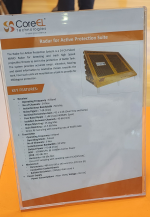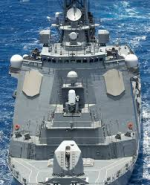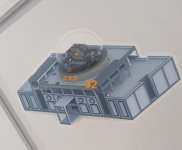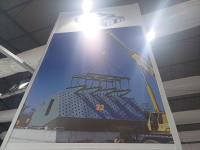Indian AESA Radar Developments
- Thread starter ni8mare
- Start date
Nextgen radars are always for next gen ships, already we have seen the evolving part in the NGC , very weapon intensive package.
Given the intention is to use long range systems on the new gen ships (like the k-15 derivative ship vector) you would need that all through to target roughly 800-1000km away while detecting enemy counter package vectors at long range.

Given the intention is to use long range systems on the new gen ships (like the k-15 derivative ship vector) you would need that all through to target roughly 800-1000km away while detecting enemy counter package vectors at long range.

It's very generous disclosure. The total number of elements is kinda similar as what i have predicted sometime ago. The arrangement is kinda similar as Netherland's SMART-L radar where there is separation between Transmit and receive "clusters". Kinda curious tho on this arrangement. Some things i have in mind is :
-Cost savings as a HPA (High Power Amplifier) is expensive. with cost/Watt is about 15-20 USD for GaAs and 14-15 for GaN. 100 Watt capable HPA is then cost about 1500 USD. This cost make parts of some 45-50% of the entire cost of a TRM. Thus The TRM might cost some 3000 USD. 14000 TRM then makes the cost about 42 M USD. The following diagram is from book "Transmit Receive Module for Radars and Communication Systems"

That 42 Million USD basically half of the Antenna face cost. The total cost of the antenna Face would be about 84 M USD. 4 faces would make it 336M USD. Since as depicted above cost of the entire AESA radar is about 78% are antenna.. then 336/0.78 = 430.8 M USD for the full 4 Faced radars with every elements capable of Transmit and receive.
430M USD is even more expensive than Garibaldi class carrier. It was offered to Indonesia for USD 390M.
Now if not all the TRM have to transmit.. you can see the great improvement there in terms of cost.
The other reason i can think of is the long pulsewidth. You can see 1ms (1000 us) Pulsewidth.. this is very long pulse. The tradeoff would be long minimum range (as 1 us radar pulse "length" equals about 150 m) 1000 us means 150000m minimum range of 150 km, target at that distance will not be detectable for a regular radar with a duplexer e.g AN/FPS-117 which have similar modes of operation. The solution for FPS-117 was to include a shorter "cover pulse" to cover the minimum range constraint.
By having separation between Transmit and receive is perhaps one can eliminate the minimum range constraint as there would be no duplexer needed. The Receive module however might include some stronger receiver protection which can withstand spillage of transmit power without being damage or de-sensitized. Thus normal operation can be performed.
The other reason is yet another cost saving but it's the possibility to reduce the amount of digital Analog to Digital Converter needed to digitize the radar returns.
-Cost savings as a HPA (High Power Amplifier) is expensive. with cost/Watt is about 15-20 USD for GaAs and 14-15 for GaN. 100 Watt capable HPA is then cost about 1500 USD. This cost make parts of some 45-50% of the entire cost of a TRM. Thus The TRM might cost some 3000 USD. 14000 TRM then makes the cost about 42 M USD. The following diagram is from book "Transmit Receive Module for Radars and Communication Systems"

That 42 Million USD basically half of the Antenna face cost. The total cost of the antenna Face would be about 84 M USD. 4 faces would make it 336M USD. Since as depicted above cost of the entire AESA radar is about 78% are antenna.. then 336/0.78 = 430.8 M USD for the full 4 Faced radars with every elements capable of Transmit and receive.
430M USD is even more expensive than Garibaldi class carrier. It was offered to Indonesia for USD 390M.
Now if not all the TRM have to transmit.. you can see the great improvement there in terms of cost.
The other reason i can think of is the long pulsewidth. You can see 1ms (1000 us) Pulsewidth.. this is very long pulse. The tradeoff would be long minimum range (as 1 us radar pulse "length" equals about 150 m) 1000 us means 150000m minimum range of 150 km, target at that distance will not be detectable for a regular radar with a duplexer e.g AN/FPS-117 which have similar modes of operation. The solution for FPS-117 was to include a shorter "cover pulse" to cover the minimum range constraint.
By having separation between Transmit and receive is perhaps one can eliminate the minimum range constraint as there would be no duplexer needed. The Receive module however might include some stronger receiver protection which can withstand spillage of transmit power without being damage or de-sensitized. Thus normal operation can be performed.
The other reason is yet another cost saving but it's the possibility to reduce the amount of digital Analog to Digital Converter needed to digitize the radar returns.
Data Pattern's stall was a surprising one. They had new AESA radars for Su-30 MKI, MiG-29K, Dornier Maritime, and two different radars for ALH. They stopped me from taking pictures.
- They are claiming that the radars on display, MKI and MiG-29K, are their own design, independent of DRDO.
- The MKI radar has a rotating repositioner. They demonstrated the repositioner working, and it was shown rotating 70 to 100 degrees. (I think, The picture that leaked on the first day is of Mig-29k not MKI).
- Dornier Maritime (Do-228 MPA) radar is under flight testing. Its called Kshitij.
- One ALH radar is for Naval Dhruv UHM helicopter with is under development by HAL.
- Additionally, there were high-band jammers which they also claim are independent of DRDO offerings.
- BrahMos Seeker, made by them, was also on display. They claimed it is already in production. I reminded him that it has yet to be test-fired. He looked puzzled.
So we have divided the workshare between two entities here? Astra Microwave for Tejas Radar and Data Patterns for Su-30. Much like the duo in US- NGES and Raytheon.Data Pattern's stall was a surprising one. They had new AESA radars for Su-30 MKI, MiG-29K, Dornier Maritime, and two different radars for ALH. They stopped me from taking pictures.
- They are claiming that the MKI and MiG-29K radars on display are their own design.
- MKI radar is with rotating repositioner. They demoed me the repositioner working. It has (I think, The picture that leaking on the first day is of Mig-29k not MKI)
- Dornier Maritime (Do-228 MPA) radar is under flight testing. Its called Kshitij.
- One ALH radar is for Naval Dhruv UHM Helicopters.
- Additionally, there were high-band jammers which they also claim are independent of DRDO offerings.
No, its internal development. Different from Virupaksha. I dont know how they are going to validate and test. They didnt answer me properly on this.So we have divided the workshare between two entities here? Astra Microwave for Tejas Radar and Data Patterns for Su-30. Much like the duo in US- NGES and Raytheon.
It would be nice in mig 29 also received aesa radar.. EW , missiles etc have to mated and certified..
We are supposed to retire it 10 years..
It's a race against time.. where we are most often late .
We are supposed to retire it 10 years..
It's a race against time.. where we are most often late .
Those upg ones are to be here for at least 15 more years. If not for navy then for IAF after withdrawn from naval service.It would be nice in mig 29 also received aesa radar.. EW , missiles etc have to mated and certified..
We are supposed to retire it 10 years..
It's a race against time.. where we are most often late .
IAF must be supporting them as they would need MKI's full RCS profile to make those ASPJs effective. Similarly, I don't see the point of fully internal development of MKI's AESA radar without IAF's involvement. Nonetheless very intersting development indeedNo, its internal development. Different from Virupaksha. I dont know how they are going to validate and test. They didnt answer me properly on this.

The space radar made by Data Patterns is likely to be delivered by next month or so, they said likely March or between Q1-Q2 next FY. Twice they have delayed the inspection and FAT from DRDO side and since every stage is user inspection mandatory so not yet delivered. Most likely the civil work is yet to finish at the site.
Accha is this also scalable to the higher side ie from quad 4x4 to say like 6x6 or 8x8 kind ?Uttam AAAU
Guy is holding 1 plank of the UTTAM:
Scaling up is always possible. Its scaling down that is the issue. Reducing the size of the individual TRM is the most difficult part of radar architecture design. We are making good progress on that front too. Watch this video from 3:15Accha is this also scalable to the higher side ie from quad 4x4 to say like 6x6 or 8x8 kind ?
The space radar made by Data Patterns is likely to be delivered by next month or so, they said likely March or between Q1-Q2 next FY. Twice they have delayed the inspection and FAT from DRDO side and since every stage is user inspection mandatory so not yet delivered. Most likely the civil work is yet to finish at the site.

DRDO's upcoming APS radar:

Specs of AMPL's APS radar:

It seems 2 companies received ToT for the APS radar. AMPL & CoreEL:
View attachment 40362
Specs of CoreEl's APS radar. No mention of range:


These Hawk-I and Hawk-II(ah) power guzzling radars attracted quite a crowd of military personnel





















